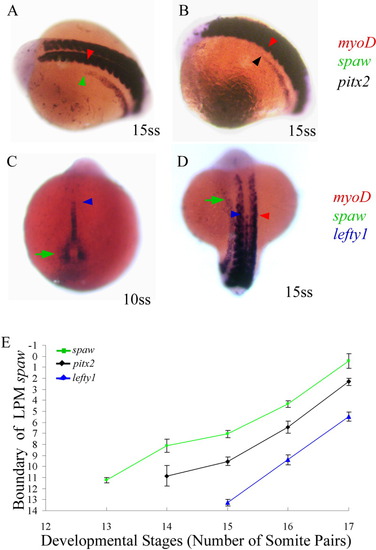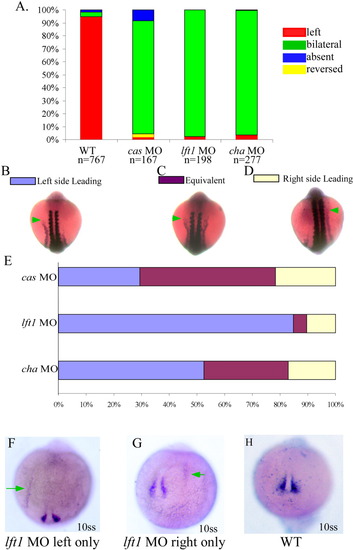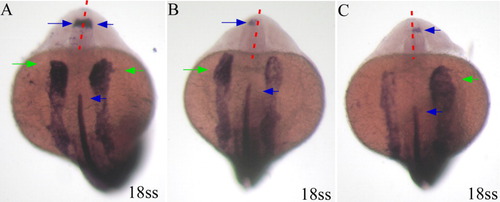- Title
-
Initiation and propagation of posterior to anterior (PA) waves in zebrafish left-right development
- Authors
- Wang, X., and Yost, H.J.
- Source
- Full text @ Dev. Dyn.
|
Quantification of the posterior to anterior propagation of spaw, pitx2 and lft1. A: At 15 somite stage (SS), the anterior boundary of lateral plate mesoderm (LPM) spaw was at somite 7. Green arrowhead: anterior expression boundary of spaw. Red arrowhead: somite corresponding to the anterior expression boundary of spaw, pitx2 or lft1. B: At 15 SS, the anterior boundary of LPM pitx2 expression was at somite 10. C,D: lft1 expression in the midline was bi-phasic. C: In the first phase, static lft1 expression was present in posterior midline before the LPM spaw expression at 10 SS. D: At approximately 15 SS, the second propagation phase of lft1 expression started. Green arrow: spaw expression. Blue arrowhead: anterior expression boundary of lft1 expression. A,B: Anterior to the left. C,D: Anterior to the top. E: Quantitative analysis of posterior-to-anterior (PA) propagation of spaw (n = 213), pitx2 (n = 74) and lft1 (n = 124). X axis is the development stages defined by total number of somite pairs. Y axis is the position of anterior expression boundary of each gene. A negative number means the anterior expression domain is anterior to the somitogenesis region. Almost 100% of embryos had detectable expression of spaw and pitx2 at stage 13 SS, 14 SS, respectively. Error bars are ± standard error. EXPRESSION / LABELING:
|
|
The posterior-to-anterior (PA) propagation of pitx2 and lft1 depends on spaw function. A,B: In wild-type (WT; A) pitx2 is expressed in lateral plate mesoderm (LPM; black arrow) and in Rohon-Beard cells (black arrowhead). In spaw morphants (B), pitx2 is not expressed in LPM but is expressed in Rohon-Beard cells (black arrowhead). Embryos were at 18 somite stage (SS); anterior to left. C,D: Spaw expression is normal in WT (C) and spaw morphants (D) in the peri-Kupffer's vesicle (KV) bilateral domains (green arrow). In contrast, left-sided LPM spaw expression (green arrowhead) and lft1 midline expression (blue arrow) seen in WT (C) is absent in spaw morphants (D). Embryos were 16 SS; anterior to the top. EXPRESSION / LABELING:
PHENOTYPE:
|
|
Distinct bilateral phenotypes in cas, cha, and lft1 morphants. A: Standard analysis of lateral plate mesoderm (LPM) spaw expression categorized as left-side expression (Red), bilateral expression (green), absent expression (blue), and reversed expression (yellow). B-D: Bilateral spaw expression in LPM is categorized as (B) the left side boundary more anterior than that of the right side (left side leading); (C) both sides with equal anterior boundaries (equivalent); (D) right side boundary was more anterior than that of the left side (right side leading). Green arrowhead: leading side spaw expression boundary. E: Quantification of cas, cha and lft1 morphants with bilateral phenotype. F-H: lft1 morphants retain LR bias at 9 to 10 somite stage (SS): (F) spaw expression in the left LPM (n = 28); (G) spaw expression in the right LPM (n = 5); (H) spaw was not expressed in WT (n = 86/88) at this stage. Green arrow: spaw expression. EXPRESSION / LABELING:
PHENOTYPE:
|
|
Correlation between orientation of the leading edge of spaw in the lateral plate mesoderm (LPM) and the orientation of lft1 in the brain in lft1 morphants. A: Majority of the morphants had bilaterally equivalent spaw expression in LPM (n = 16) and bilateral lft1 expression in brain. B: In the morphants with stronger spaw expression in the left LPM, lft1 expression was observed only in the left side of the brain (n = 12). C: In morphants with stronger spaw in the right LPM, lft1 expression was observed only in the right side of the brain (n = 3). Red dot line: midline; blue arrow: lft1; green arrow: spaw. EXPRESSION / LABELING:
|




